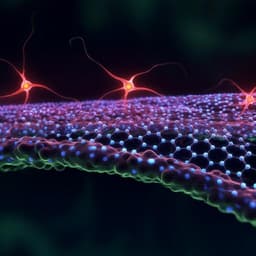
Medicine and Health
Photovoltaic retinal prosthesis restores high-resolution responses to single-pixel stimulation in blind retinas
N. A. L. Chenais, M. J. I. A. Leccardi, et al.
Retinal prostheses show promise in restoring vision for the blind, yet current trials indicate certain limitations. Discover POLYRETINA, a cutting-edge epiretinal prosthesis boasting 10,498 independent pixels, achieving remarkable spatial resolution for mid-peripheral vision in retinitis pigmentosa patients. This exciting research was conducted by Naïg Aurelia Ludmilla Chenais, Marta Jole Ildelfonsa Airaghi Leccardi, and Diego Ghezzi.
~3 min • Beginner • English
Introduction
The study addresses the central challenge in retinal prosthetics of independently activating retinal neurons across a wide visual field to improve functional vision in profoundly blind individuals, particularly those with retinitis pigmentosa. Existing implants (e.g., Argus II epiretinal, PRIMA and Alpha-AMS subretinal) are limited by narrow visual angles (often ≤20°), low electrode counts and density, axonal activation distorting retinotopy, and cognitively demanding scanning due to small fields. Simulations suggest at least ~30° visual angle is needed for everyday tasks, while clinical performance remains limited by spatial resolution and field of view. The authors propose a wide-field, curved, organic photovoltaic epiretinal prosthesis (POLYRETINA) with high pixel density to deliver network-mediated stimulation that minimizes axon activation, aiming to achieve both broad coverage and high-resolution stimulation. They investigate whether high-density pixels yield high response discrimination at the retinal ganglion cell (RGC) level despite retinal network interconnectivity.
Literature Review
Retinal prostheses have progressed to clinical use predominantly for retinitis pigmentosa, yet users often discontinue devices within 1–3 years and report limited quality-of-life improvements. Epiretinal systems like Argus II provide ~20° visual angle with 6×10 electrodes at 525 µm pitch, constraining resolution and necessitating head scanning. Subretinal systems have achieved higher acuities: PRIMA (Landolt-C 20/460) and Alpha-AMS (20/546); grating acuities reported range from 20/1260 (Argus II) to 20/364 (Alpha-AMS). Wide-field arrays have been proposed for epiretinal placement to meet visual angle needs but are constrained by implantable hardware, transscleral cabling, and feedlines that limit density, and by epiretinal nerve fiber activation that distorts retinotopy. Photovoltaic approaches increase electrode count/density, but previous devices often cover limited retinal area (~6°). Conjugated polymer interfaces and alternative materials (TiO2 nanotubes, Au–TiO2 nanowires) have shown promise for neural/retinal stimulation, with continuous films enabling focused stimulation due to low carrier mobility/lifetime. However, for wide-field coverage on curved retina, discrete mechanically protected pixels are needed to avoid cracking and delamination. Prior work suggests longer, non-rectangular pulses can favor network-mediated RGC activation and reduce axonal phosphenes.
Methodology
Device design and fabrication: High-density POLYRETINA consists of 10,498 independent photovoltaic pixels (80 µm diameter, 120 µm pitch; 79.1 pixels mm⁻²) over a 13–13.4 mm active diameter curved array (~43° visual angle). Structure: PDMS base (50 µm), SU-8 platforms (6 µm), PDMS embedding (15 µm), PEDOT:PSS (50 nm), P3HT:PC60BM (100 nm), Ti/TiN cathodes (80/60 nm), PDMS encapsulation (4 µm). Ti electrodes were coated with TiN to enhance stimulation efficiency and reduce mechanical stress. Pixels were physically isolated by patterning polymer layers.
Mechanical simulations: Finite element analysis (Abaqus/CAE 6.14) estimated tensile stress/strain in pixels during hemispherical shaping, comparing Ti vs TiN coatings.
Voltage spread measurements: Using a glass microelectrode positioned 2–5 µm above the array in Ames’ medium at 32 °C, the radial voltage profile was measured for single-pixel and multi-pixel activation (560 nm, 10 ms; irradiance up to 22.65 mW mm⁻²). Measurements in three principal directions across 25 positions each were interpolated to 2D maps; voltage profiles were normalized.
Optoelectronic characterization: Kelvin Probe Force Microscopy (KPFM) measured surface potential change at the cathode upon illumination (560 nm, 60 s, 0.9 mW mm⁻²) for Ti vs TiN pixels. Photocurrent density (PCD) and photovoltage (PV) were measured on chips with six individually contacted pixels in saline with a Pt reference electrode upon 565-nm, 10-ms pulses across irradiances (including 0.9 mW mm⁻²). Atomic force microscopy quantified cathode surface area/roughness.
Ex vivo electrophysiology: Explanted rd10 mouse retinas (late degeneration; mean age ~127 days; both sexes) were mounted epiretinally on the prosthesis. Single-electrode extracellular recordings captured RGC activity. Light pulses (560 nm, 10 ms) were delivered at various irradiances (0.014–22.65 mW mm⁻²) under large-field (~70 pixels) and single-pixel stimulation. Ten pulses at 1 Hz per condition. Medium-latency (ML) network-mediated responses were quantified in a 50-ms window centered on the peak in 40–120 ms post-stimulus. DL-AP4 (250 µM) was applied in a subset to block ON bipolar cell synaptic input and test for photoreceptor contribution.
Photovoltaic receptive fields (RFs): For 31 RGCs, the 19 pixels surrounding the recording site were sequentially illuminated (560 nm, 10 ms, 0.9 mW mm⁻², 1 Hz) for 10 sweeps. ML responses per pixel were mapped and fitted with 2D Gaussians to estimate RF size/shape; pixels eliciting significant activation (P<0.05) were counted. Gaussian mixture modeling classified small vs large RF clusters.
Spatial resolution tests: Two-point discrimination via pixel-switch paradigm: repetitive 5-Hz stimulation (560 nm, 10 ms, 0.9 mW mm⁻²) from one pixel for 1 s then switching to the adjacent pixel for 1 s; ML response recovery at reversal was assessed against a defined recovery threshold. Grating pattern reversal: high-contrast vertical bar gratings (black/green, 560 nm, 10 ms, 0.9 mW mm⁻²) at 5 Hz for 3 s, reversing every five pulses. Fixed bar width 120 µm in 26 RGCs; variable widths (200, 160, 120, 100, 70 µm) in 18 RGCs to determine resolution limit (criterion: reversal ML response ≥1.66× desensitized baseline).
Contrast control: Large-field illumination at 5 Hz with irradiance steps (0.9 → 2.34 → 0.35 mW mm⁻²) without spatial changes tested for ML response recovery at irradiance transitions.
Thermal safety modeling: COMSOL Multiphysics Bioheat and Beer–Lambert models simulated iris temperature rise with a 2-mm diameter 565-nm beam under worst-case stationary exposure. MPE for retinal safety was computed; time to 2 °C iris rise vs irradiance was quantified; implications for pulsed operation and eye-tracking-based beam steering were assessed.
Statistical analysis: Normality tests guided parametric/non-parametric comparisons; unpaired/paired t-tests and ANOVA used as appropriate; results reported with P-values and mean ± s.e.m./s.d.
Key Findings
- Device and mechanics: POLYRETINA integrates 10,498 independent pixels (80 µm diameter, 120 µm pitch) over a 13.4-mm active area (~43°). TiN coating reduced simulated tensile strain (from −0.55% with Ti to −0.13% with TiN) and stress (from 574.8 MPa to 310.9 MPa) during hemispherical shaping.
- Electrical independence: Voltage spread mapping showed signals remained localized above the illuminated pixel even at 22.65 mW mm⁻²; no crosstalk or summation from neighboring pixels in patterns with 1, 7, 19, or 18 (surround-only) illuminated pixels.
- Optoelectronic performance: TiN increased surface potential change (KPFM; P=0.0083), photocurrent density and photovoltage across irradiances; at 0.9 mW mm⁻², both PCD (P=0.0288) and PV (P<0.0001) were higher for TiN vs Ti. AFM showed higher effective surface area with TiN (P=0.0024).
- RGC activation efficacy (560–565 nm, 10 ms): At 0.9 mW mm⁻², large-field stimulation evoked significant ML spiking over baseline for both Ti (P=0.0088) and TiN (P<0.0001). Single-pixel stimulation also evoked significant ML activity (Ti: P=0.0378; TiN: P=0.0062). Fraction of RGCs activated at 0.9 mW mm⁻²: Ti, large-field 16/20; Ti, single-pixel 7/20; TiN, large-field 21/21; TiN, single-pixel 12/21. With TiN single-pixel, 57% activated at 0.9 mW mm⁻², others at higher irradiance.
- Activation thresholds: In TiN single-pixel responsive RGCs (n=30), ML firing rate increased with irradiance; population activation threshold ~79 µW mm⁻² (10% of maximal ML at 0.9 mW mm⁻²). Individual thresholds varied; >50% (18/30) had thresholds ≤0.35 mW mm⁻²; only 6/30 responded at 0.16 mW mm⁻². DL-AP4 did not alter ML response curves or thresholds (P=0.68), excluding contribution of spared photoreceptors.
- Photovoltaic RFs: Most RGCs (24/31) showed small RF radii (34.5–142.5 µm); 5/31 had large RFs (184.3–282.7 µm); 2/31 elongated RFs. Gaussian mixture clusters yielded average RF diameters: small 153.7 ± 26.1 µm (mean ± s.e.m.), large 335.5 ± 49.3 µm. Small-RF cells were activated by an average of ~3 pixels; some by a single pixel.
- Spatial resolution: Continuous 5-Hz stimulation from one pixel induced desensitization by pulse 2; switching to an adjacent pixel recovered the ML response above the recovery threshold (P=0.0226) and to naïve levels (P=0.9054), indicating two-point discrimination at 120 µm (pixel pitch). Grating pattern reversal at 120-µm bars showed ML recovery at reversals (P=0.0081 and P=0.0140), comparable to naïve responses (ANOVA P≈0.90). Resolution limits across 18 RGCs: 7/18 resolved 120 µm, 6/18 resolved 100 µm, 3/18 resolved 70 µm; 2/18 required 160–200 µm. Some super-pitch resolution likely due to nonlinear subunit integration.
- Contrast control: Irradiance steps without spatial change did not produce ML recovery at transitions (P=0.1224; P=0.8546), confirming spatial, not contrast, origin of reversals’ response recovery.
- Safety modeling: Retinal MPE at 565 nm for 43° exposed area allowed 47.90 mW entering pupil in continuous exposure; pulsed operation (10 ms; 5/10/20 Hz) increases MPE to ~8.32/4.16/2.08 mW mm⁻² at the retina considering prior thermal modeling. Worst-case iris heating with a 2-mm beam at 15.25 mW mm⁻² would exceed +2 °C in 150 s; maintaining <2 °C rise requires ≤2.25 mW mm⁻² for chronic exposure. Time to +2 °C at 15.25 mW mm⁻² is ~460 ms, extending with lower irradiance. Eye movements and eye-tracking-based beam steering can mitigate thermal load while retaining irradiance above activation thresholds.
Discussion
The results demonstrate that a wide-field, conformable, high-density organic photovoltaic epiretinal array can deliver spatially selective, network-mediated RGC activation with single-pixel stimuli at irradiances below safety limits. TiN-coated pixels improved mechanical robustness and optoelectronic efficiency, enabling more cells to be driven at lower irradiances. Electrical independence and localized photovoltage under single-pixel illumination prevented crosstalk, preserving retinotopic selectivity. Two-point discrimination and grating reversal paradigms showed functional spatial resolution equivalent to the 120-µm pixel pitch, with some cells achieving finer discrimination, indicating that network-mediated epiretinal stimulation can reach high spatial precision without axonal activation dominating. Mapping photovoltaic RFs revealed most cells are driven by one to few pixels, supporting high-resolution encoding. Safety analyses suggest operating windows where irradiance and pulse rates meet retinal and iris thermal constraints, especially with beam steering.
These findings directly address the dual limitations of field of view and resolution in epiretinal prostheses by combining a ~43° visual angle with high-density pixels that maintain high spatial selectivity at the RGC level. Estimated theoretical acuity (~20/480) approaches subretinal devices’ performance while offering a much wider field, potentially benefiting navigation, scene mapping, and object interaction. Translational considerations include differences between mouse and human RGC RF sizes (smaller in fovea/parafovea), potential phosphene distortions from axonal activation (mitigated by long, capacitive-like pulses), and optimization of operating wavelengths and stimulation rates.
Conclusion
POLYRETINA, a curved, wide-field organic photovoltaic epiretinal prosthesis with 10,498 TiN-coated pixels, achieves spatially selective, network-mediated activation of RGCs with single-pixel stimuli at safe irradiances. The device exhibits minimal crosstalk, improved optoelectronic performance with TiN, and response discrimination at least matching its 120-µm pitch, with many cells resolving 100–120 µm gratings and some resolving 70 µm. Photovoltaic receptive fields are typically small, involving one to a few pixels. Thermal modeling outlines operating regimes and the value of beam steering to ensure safety. Overall, the approach promises mid-peripheral artificial vision with improved spatial resolution and broad visual angle for retinitis pigmentosa.
Future work should include: in vivo preclinical validation of safety and efficacy; human psychophysical studies to optimize stimulation parameters (pulse rates, durations) and assess phosphene quality; development of red/NIR-sensitive polymers to avoid residual photoreceptor activation and reduce perceived brightness; integration of eye-tracking-based beam control; and exploration of design adjustments (e.g., visual angle, pixel pitch) to balance thermal constraints with functional needs.
Limitations
- Experiments were ex vivo in rd10 mouse retinas; translation to human percepts and behavior requires in vivo and clinical evaluation.
- Visible-wavelength activation (P3HT-based) may stimulate residual photoreceptors or be perceptible even in blind patients; wavelength shift to NIR is needed.
- Potential for direct axonal activation remains, though probability is low with long capacitive pulses; impact on perceptual phosphene shape in humans is uncertain.
- Thermal constraints at the iris limit maximal irradiance and pulse rates under worst-case conditions; real-world mitigation requires reliable eye tracking and beam control.
- RGC activation thresholds and resolution varied due to variable alignment between pixels and cells’ presynaptic networks; precise alignment was not controlled with single-electrode recordings.
- Human RGC RF sizes vary with eccentricity; the demonstrated 120-µm pitch may set acuity limits centrally, while mid-peripheral resolution depends on cell class and arborization.
Related Publications
Explore these studies to deepen your understanding of the subject.







